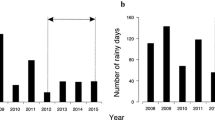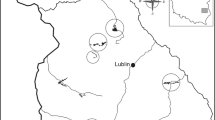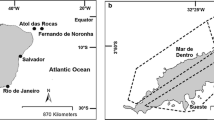Abstract
Lemmings play a key role in the tundra food web and their widely reported cyclic oscillations in abundance may have a strong effect on other components of the ecosystem. We documented seasonal and annual variations in population density, reproductive activity, survival, and body mass of two sympatric species, the brown (Lemmus trimucronatus) and collared lemmings (Dicrostonyx groenlandicus), over a 2-year period on Bylot Island, Nunavut, Canada. We live trapped and marked lemmings on two grids throughout the summer and we estimated demographic parameters using three different capture–recapture methods. All three methods are based on robust estimators and they yielded similar population density estimates. The density of brown lemmings declined markedly between the 2 years whereas that of collared lemmings was relatively constant. For brown lemmings, 2004 was a peak year in their cycle and 2005 a decline phase. Density of brown lemmings also decreased during the summer, but not that of collared lemmings. The recruitment of juvenile brown lemmings in the population increased during the summer and was higher in the peak year than in the year after, but no change was detected in collared lemmings. Survival rates of both species tended to be lower during the peak year than in the following year and body mass of brown lemmings was higher in the peak year than in the following year. We conclude that both changes in adult survival and juvenile recruitment occur during the population decline of brown lemmings.





Similar content being viewed by others
References
Angerbjörn A, Tannerfeldt M, Erlinge S (1999) Predator–prey relationships: arctic foxes and lemmings. J Anim Ecol 68:34–49
Angerbjörn A, Tannerfeldt M, Lundberg H (2001) Geographical and temporal patterns of lemming population dynamics in Fennoscandia. Ecography 24:298–308
Banfield AWF (1974) The mammals of Canada. University of Toronto Press, Toronto
Banks EM, Brooks RJ, Schnell J (1975) Radiotracking study of home range and activity of brown lemmings (Lemmus trimucronatus). J Mammal 56:888–901
Batzli GO, Jung HJG (1980) Nutritional ecology of microtine rodents—resource utilization near Atkasook, Alaska. Arct Alp Res 12:483–499
Blackburn GS, Wilson DJ, Krebs CJ (1998) Dispersal of juvenile collared lemmings (Dicrostonyx groenlandicus) in a high-density population. Can J Zool 76:2255–2261
Burnham KP, Anderson DR (1998) Model selection and inference: a practical information-theoretic approach. Springer-Verlag, New York
Chitty D (1996) Do lemmings commit suicide? Beautiful hypotheses and ugly facts. Oxford University Press, Oxford
Choquet R, Reboulet AM, Lebreton JD, Gimenez O, Pradel R (2005) U-CARE 2.2 User’s Manual. Centre d’Écologie Fonctionnelle et Évolutive, Montpellier
Duchesne D (2009) Sélection de l’habitat, reproduction et prédation hivernale chez les lemmings de l’Arctique. M.Sc. Thesis, Université Laval, Québec
Duclos I (2002) Milieux mésiques et secs de l’Île Bylot, Nunavut (Canada): Caractérisation et utilisation par la Grande Oie des Neiges. M.Sc. Thesis, Université du Québec à Trois-Rivières, Trois-Rivières
Efford MG (2004) Density estimation in live-trapping studies. Oikos 106:598–610
Efford MG, Dawson DK, Robbins CS (2004) DENSITY: software for analysing capture–recapture data from passive detector arrays. Anim Biodivers Conserv 27:217–228
Efford MG, Warburton B, Coleman MC, Barker RJ (2005) A field test of two methods for density estimation. Wildl Soc Bull 33:731–738
Elton CS (1924) Periodic fluctuations in the numbers of animals: their causes and effects. J Exp Biol 2:119–163
Erlinge S, Danell K, Frodin P, Hasselquist D, Nilsson P, Olofsson EB, Svensson M (1999) Asynchronous population dynamics of Siberian lemmings across the Palaearctic tundra. Oecologia 119:493–500
Erlinge S, Hasselquist D, Svensson M, Frodin P, Nilsson P (2000) Reproductive behaviour of female Siberian lemmings during the increase and peak phase of the lemming cycle. Oecologia 123:200–207
Framstad E, Stenseth NC, Ostbye E (1993a) Demography of Lemmus lemmus through five population cycles. In: Stenseth NC, Ims RA (eds) The biology of lemmings. Academic Press, London, pp 117–134
Framstad E, Stenseth NC, Ostbye E (1993b) Times series analysis of population fluctuations of Lemmus lemmus. In: Stenseth NC, Ims RA (eds) The biology of lemmings. Academic Press, London, pp 97–116
Fuller WA, Martell AM, Smith RFC, Speller SW (1975) High-arctic lemmings, Dicrostonyx groenlandicus. II. Demography. Can J Zool 53:867–878
Gauthier G, Rochefort L, Reed A (1996) The exploitation of wetland ecosystems by herbivores on Bylot Island. Geosci Can 23:253–259
Gauthier G, Bêty J, Giroux JF, Rochefort L (2004) Trophic interactions in a high arctic snow goose colony. Integr Comp Biol 44:119–129
Gauthier G, Berteaux D, Krebs CJ, Reid D (2009) Arctic lemmings are not simply food limited—a comment. Evol Ecol Res 11:483–484
Gibbons JW, Andrews KM (2004) PIT tagging: simple technology at its best. Bioscience 54:447–454
Gilg O (2002) The summer decline of the collared lemming, Dicrostonyx groenlandicus, in high arctic Greenland. Oikos 99:499–510
Gilg O, Hanski I, Sittler B (2003) Cyclic dynamics in a simple vertebrate predator–prey community. Science 302:866–868
Gilg O, Sittler B, Sabard B, Hurstel A, Sane R, Delattre P, Hanski L (2006) Functional and numerical responses of four lemming predators in high arctic Greenland. Oikos 113:193–216
Gruyer N (2007) Étude comparative de la démographie de deux espèces de lemmings (Lemmus sibericus et Dicrostonyx groenlandicus) à l’Île Bylot, Nunavut, Canada. M.Sc. Thesis, Université Laval, Québec
Gruyer N, Gauthier G, Berteaux D (2008) Cyclic dynamics of sympatric lemming populations on Bylot Island, Nunavut, Canada. Can J Zool 86:910–917
Hanski I, Henttonen H, Korpimaki E, Oksanen L, Turchin P (2001) Small-rodent dynamics and predation. Ecology 82:1505–1520
Hansson L (1983) Differences in age indicators between field and laboratory small rodent populations. Mammalia 47:371–375
Ims RA, Fuglei E (2005) Trophic interaction cycles in tundra ecosystems and the impact of climate change. Bioscience 55:311–322
Ims RA, Henden JA, Killengreen ST (2008) Collapsing population cycles. Trends Ecol Evol 23:79–86
Kendall WL, Nichols JD (1995) On the use of secondary capture–recapture samples to estimate temporary emigration and breeding proportions. J Appl Stat 22:751–762
Kendall WL, Nichols JD, Hines JE (1997) Estimating temporary emigration using capture–recapture data with Pollock’s robust design. Ecology 78:563–578
Klemola T, Korpimaki E, Koivula M (2002) Rate of population change in voles from different phases of the population cycle. Oikos 96:291–298
Korpimaki E, Klemola T, Norrdahl K, Oksanen L, Oksanen T, Banks PB, Batzli GO, Henttonen H (2003) Vole cycles and predation. Trends Ecol Evol 18:494–495
Korpimaki E, Brown PR, Jacob J, Pech RP (2004) The puzzles of population cycles and outbreaks of small mammals solved? Bioscience 54:1071–1079
Krebs CJ (1964) The lemming cycle at Baker Lake, Northwest Territories, during 1959–1962. Technical Paper No. 15, Arctic Institute of North America, Calgary
Krebs CJ (2002) Two complementary paradigms for analysing population dynamic. Phil Trans R Soc Lond B 357:1211–1219
Krebs CJ, Gaines MS, Keller BL, Myers JH, Tamarin RH (1973) Population cycles in small rodents. Science 179:35–41
Krebs CJ, Boonstra R, Kenney AJ (1995) Population dynamics of the collared lemming and the tundra vole at Pearce-Point, Northwest-Territories, Canada. Oecologia 103:481–489
Krebs CJ, Danell K, Angerbjörn A, Agrell J, Berteaux D, Bråthen KA, Danell O, Erlinge S, Fedorov V, Fredga K, Hjalten J, Hogstedt G, Jónsdóttir IS, Kenney A, Kjellen N, Nordin T, Roininen H, Svensson M, Tannerfeldt M, Wiklund CG (2003) Terrestrial trophic dynamics in the Canadian Arctic. Can J Zool 81:827–843
Lambin X, Bretagnolle V, Yoccoz NG (2006) Vole population cycles in northern and southern Europe: is there a need for different explanations for single pattern? J Anim Ecol 75:340–349
Mallory FF, Elliott JR, Brooks RJ (1981) Changes in body size in fluctuating populations of collared lemmings: age and photoperiod influences. Can J Zool 59:174–182
Millar JS (2001) On reproduction in lemmings. Ecoscience 8:145–150
Morris DW, Davidson DL, Krebs CJ (2000) Measuring the ghost of competition: Insights from density-dependent habitat selection on the co-existence and dynamics of lemmings. Evol Ecol Res 2:41–67
Negus NC, Berger PJ (1998) Reproductive strategies of Dicrostonyx groenlandicus and Lemmus sibiricus in high-arctic tundra. Can J Zool 76:390–399
Norrdahl K, Korpimaki E (2002) Changes in individual quality during a 3-year population cycle of voles. Oecologia 130:239–249
Norrdahl K, Heinila H, Klemola T, Korpimaki E (2004) Predator-induced changes in population structure and individual quality of Microtus voles: a large-scale field experiment. Oikos 105:312–324
Oksanen T, Oksanen L, Dahlgren J, Olofsson J (2008) Arctic lemmings, Lemmus spp. and Dycrostonyx spp.: integrating ecological and evolutionary perspectives. Evol Ecol Res 10:415–434
Ostbye E, Semb-Johansson A (1970) The eyes lens as an age indicator in the Norwegian lemming (Lemmus lemmus). Nor J Zool 18:239–243
Otis DL, Burnham KP, White GC, Anderson DR (1978) Statistical inference from capture data on closed animal population. Wildlife Monogr No 62. The Wildlife Society, Louiseville
Parmenter RR, Yates TL, Anderson DR, Burnham KP, Dunnum JL, Franklin AB, Friggens MT, Lubow BC, Miller M, Olson GS, Parmenter CA, Pollard J, Rexstad E, Shenk TM, Stanley TR, White GC (2003) Small-mammal density estimation: a field comparison of grid-based vs. web-based density estimators. Ecol Monogr 73:1–26
Pitelka FA (1973) Cyclic pattern in lemming populations near Barrow, Alaska. Am Tech Pap 25:199–215
Pitelka FA, Batzli GO (1993) Distribution, abundance and habitat use by lemmings on the north slope of Alaska. In: Stenseth NC, Ims RA (eds) The biology of lemmings. Academic Press, London, pp 198–213
Predavec M, Krebs CJ (2000) Microhabitat utilisation, home ranges, and movement patterns of the collared lemming (Dicrostonyx groenlandicus) in the central Canadian Arctic. Can J Zool 78:1885–1890
Reid DG, Krebs CJ, Kenney A (1995) Limitation of collared lemming population-growth at low-densities by predation mortality. Oikos 73:387–398
Rodgers AR, Lewis MC (1986a) Diet selection in Arctic lemmings (Lemmus sibiricus and Dicrostonyx groenlandicus): forage availability and natural diets. Can J Zool 64:1684–1689
Rodgers AR, Lewis MC (1986b) Diet selection in Arctic lemmings: demography, home range, and habitat use. Can J Zool 64:2717–2727
Sokal RR, Rohlf FJ (1995) Biometry: the principles and practice of statistics in biological research, 3rd edn. WH Freeman and Company, New York
Stenseth NC (1999) Population cycles in voles and lemmings: density dependence and phase dependence in a stochastic world. Oikos 87:427–461
Stenseth NC, Ims RA (1993a) Intra- and interspecific relations: an introduction. In: Stenseth NC, Ims RA (eds) The biology of lemmings. Academic Press, London, pp 341–354
Stenseth NC, Ims RA (1993b) Population dynamics of lemmings: temporal and spatial variation: an introduction. In: Stenseth NC, Ims RA (eds) The biology of lemmings. Academic Press, London, pp 61–96
Sundell J (2006) Experimental tests of the role of predation in the population dynamics of voles and lemmings. Mammal Rev 36:107–141
Turchin P, Batzli GO (2001) Availability of food and the population dynamics of arvicoline rodents. Ecology 82:1521–1534
Turchin P, Oksanen L, Ekerholm P, Oksanen T, Henttonen H (2000) Are lemmings prey or predators? Nature 405:562–565
Unangst ET, Wunder BA (2002) Effects of trap retention on body composition of live meadow voles. Physiol Biochem Zool 75:627–634
White GC, Burnham KP (1999) Program MARK: survival estimation from populations of marked animals. Bird Study 46:120–139
Williams BK, Nichols JD, Conroy MJ (2002) Analysis and management of animal populations. Academic Press, San Diego
Wilson DJ, Krebs CJ, Sinclair T (1999) Limitation of collared lemming populations during a population cycle. Oikos 87:382–398
Acknowledgments
We thank Nicolas Ouellet, Nicolas Lecomte, Marie-Hélène Dickey and Maude Graham-Sauvé for their help in the field, Louis-Paul Rivest for his help with statistical analyses and Daniel Fortin, Steeve Côté and Olivier Gilg for their comments on an earlier version of the manuscript. Funding was provided by grants from the Natural Sciences and Engineering Research Council of Canada to G. Gauthier, the Fonds québécois pour la nature et les technologies, the Canadian Network of Centres of Excellence ArcticNet, the Northern Ecosystem Initiative (Environment Canada), the Arctic Goose Joint Venture (Canadian Wildlife Service), the Canada Foundation for Innovation to D. Berteaux, and Indian and Northern Affairs Canada. Logistic supports were generously provided by the Polar Continental Shelf Program, Natural Resources Canada. We are indebted to the Pond Inlet Hunter and Trapper Association (Nunavut Territory) and to Parks Canada for allowing us to work on Bylot Island. The manipulations of this study were approved by the Committee for Animal Protection of Université Laval and conducted under research permits issued by Parks Canada. This is Polar Continental Shelf Program contribution no 048-09.
Author information
Authors and Affiliations
Corresponding author
Rights and permissions
About this article
Cite this article
Gruyer, N., Gauthier, G. & Berteaux, D. Demography of two lemming species on Bylot Island, Nunavut, Canada. Polar Biol 33, 725–736 (2010). https://doi.org/10.1007/s00300-009-0746-7
Received:
Revised:
Accepted:
Published:
Issue Date:
DOI: https://doi.org/10.1007/s00300-009-0746-7




